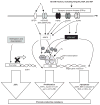Roles for miRNAs in endocrine resistance in breast cancer
- PMID: 26346768
- PMCID: PMC4563344
- DOI: 10.1530/ERC-15-0355
Roles for miRNAs in endocrine resistance in breast cancer
Abstract
Therapies targeting estrogen receptor alpha (ERα), including selective ER modulators such as tamoxifen, selective ER downregulators such as fulvestrant (ICI 182 780), and aromatase inhibitors such as letrozole, are successfully used in treating breast cancer patients whose initial tumor expresses ERα. Unfortunately, the effectiveness of endocrine therapies is limited by acquired resistance. The role of microRNAs (miRNAs) in the progression of endocrine-resistant breast cancer is of keen interest in developing biomarkers and therapies to counter metastatic disease. This review focuses on miRNAs implicated as disruptors of antiestrogen therapies, their bona fide gene targets and associated pathways promoting endocrine resistance.
Keywords: antiestrogen; aromatase inhibitor; breast cancer; endocrine-resistance; estrogen receptor; miRNA; tamoxifen.
© 2015 Society for Endocrinology.
Conflict of interest statement
The authors declare that there is no conflict of interest that could be perceived as prejudicing the impartiality of this review.
Figures



Similar articles
-
Identification of miRNAs as biomarkers for acquired endocrine resistance in breast cancer.Mol Cell Endocrinol. 2017 Nov 15;456:76-86. doi: 10.1016/j.mce.2017.02.004. Epub 2017 Feb 3. Mol Cell Endocrinol. 2017. PMID: 28163101 Review.
-
Autophagy and endocrine resistance in breast cancer.Expert Rev Anticancer Ther. 2011 Aug;11(8):1283-94. doi: 10.1586/era.11.111. Expert Rev Anticancer Ther. 2011. PMID: 21916582 Free PMC article. Review.
-
MicroRNA-221/222 confers breast cancer fulvestrant resistance by regulating multiple signaling pathways.Oncogene. 2011 Mar 3;30(9):1082-97. doi: 10.1038/onc.2010.487. Epub 2010 Nov 8. Oncogene. 2011. PMID: 21057537 Free PMC article.
-
Tamoxifen-resistant fibroblast growth factor-transfected MCF-7 cells are cross-resistant in vivo to the antiestrogen ICI 182,780 and two aromatase inhibitors.Clin Cancer Res. 1998 Mar;4(3):697-711. Clin Cancer Res. 1998. PMID: 9533540
-
Aurora kinase B is important for antiestrogen resistant cell growth and a potential biomarker for tamoxifen resistant breast cancer.BMC Cancer. 2015 Apr 8;15:239. doi: 10.1186/s12885-015-1210-4. BMC Cancer. 2015. PMID: 25885472 Free PMC article.
Cited by
-
Predictive and Prognostic Value of Selected MicroRNAs in Luminal Breast Cancer.Front Genet. 2019 Sep 11;10:815. doi: 10.3389/fgene.2019.00815. eCollection 2019. Front Genet. 2019. PMID: 31572437 Free PMC article.
-
MicroRNA Expression Profiles and Breast Cancer Chemotherapy.Int J Mol Sci. 2021 Oct 6;22(19):10812. doi: 10.3390/ijms221910812. Int J Mol Sci. 2021. PMID: 34639152 Free PMC article. Review.
-
A feedback loop consisting of RUNX2/LncRNA-PVT1/miR-455 is involved in the progression of colorectal cancer.Am J Cancer Res. 2018 Mar 1;8(3):538-550. eCollection 2018. Am J Cancer Res. 2018. PMID: 29637007 Free PMC article.
-
Investigation of circulating miR-182-3p, miR -382-3p and miR -93, miR -142-3p involved in tamoxifen resistance and sensitivity in luminal-subtype breast cancer patients: a case-control study.Naunyn Schmiedebergs Arch Pharmacol. 2025 Jun;398(6):7505-7516. doi: 10.1007/s00210-024-03770-9. Epub 2025 Jan 4. Naunyn Schmiedebergs Arch Pharmacol. 2025. PMID: 39754680
-
miR-190 enhances endocrine therapy sensitivity by regulating SOX9 expression in breast cancer.J Exp Clin Cancer Res. 2019 Jan 18;38(1):22. doi: 10.1186/s13046-019-1039-9. J Exp Clin Cancer Res. 2019. PMID: 30658681 Free PMC article.
References
-
- Tamoxifen for early breast cancer: an overview of the randomised trials. Early Breast Cancer Trialists’ Collaborative Group. . Lancet. 1998;351:1451–1467. - PubMed
-
- Acconcia F, Ascenzi P, Fabozzi G, Visca P, Marino M. S-palmitoylation modulates human estrogen receptor-alpha functions. Biochemical and Biophysical Research Communications. 2004;316:878–883. - PubMed
-
- Anbalagan M, Rowan BG. Estrogen receptor alpha phosphorylation and its functional impact in human breast cancer. Mol Cell Endocrinol 2015 - PubMed
Publication types
MeSH terms
Substances
Grants and funding
LinkOut - more resources
Full Text Sources
Other Literature Sources
Medical

